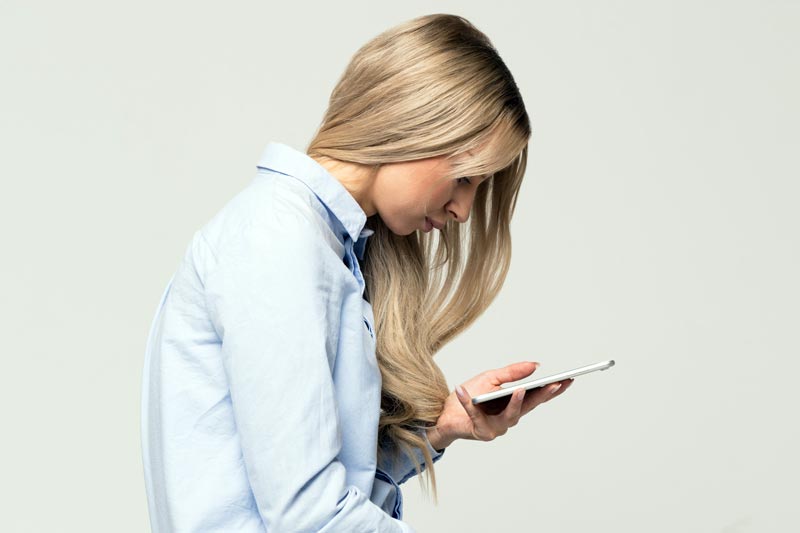Self Care – Neck-ache Headache, Eye-ache
Table of Contents
- Activities to Avoid or Change
- For Temporary Relief
- Stretches and Exercises for Longer-Lasting Relief
- Yoga Corner
This post has self-care strategies for relief from neckache, headache, eye-ache. If you’d like to read more about how people describe this pain and the activities that create the problem and aggravate it look at this other post.
Activities To Avoid or Change:
Avoid this sharp bend at the base of the neck instead of using his eyes to look down. It is worse if you’re turning to one side at the same time. It’s common in more than texting. Although “text neck” or “iHunch” is a chronic problem, several other activities contribute to this chronic posture. Those include:
- leaning back in your car seat
- sleeping under a cold draft in the fetal position
- birdwatching
- craning toward the screen with virtual meetings
- leaning down to attend to detailed work on a table
- sitting with your hips pulled forward
Improve the ergonomics
at your home or office.
This post offers some great ideas for actively sitting without support or sitting with supports that help you avoid pain and fatigue. There are also suggestions about a few useful accessories.
For Temporary Relief:
Neck Patch, Not Eye Patch
Place one of these Salonpas patches over the center of the upper neck. It usually feels tense there when you have this headache. Even though this headache focuses on the eye, this particular spot in the center of the neck is where the headache starts.
After several minutes, when you start to feel the patch, gently stretch from side to side. There are usually some little clicks in the middle and upper neck as this releases.
Stay away from treating this with a heating pad. It feels good for a couple of hours but often gets inflamed a few hours later. Ice is a better passive treatment.
Cool, Chill, Relax
This pillow with the built-in ice pack from Amazon can offer relief, especially, if you tuck your chin. It is great when seated, but it’s better to use these standard cloth-covered ice packs if you like to lay on the ice. One of those is included with the pillow if you want both options.
These self-care activities, like over-the-counter drugs, are not intended to replace appropriate medical attention. If you have concerns about these self-care activities, get help from a professional. Use these suggestions and strategies with discretion and at your own risk. See your doctor when your pain is severe, persistent, or not responding to these simple suggestions.
Stretches and Exercises for Longer-Lasting Relief:
Do The Box.
When stretching the top of the neck, focus on the sides and the back. When stretching the bottom of the neck, focus on the sides and the front. This approach will allow the neck to move back and take tension off of the splenius crevices. Again, there are often a few little clicks as the vertebrae mobilize and the muscle relaxes.
The little clicks in the top of the neck will give relief, but the stretching of the lower neck will change posture for lasting relief.
Releasing this trigger point can offer noticeable relief for people with anxiety or Sensory Integration Dysfunction.
I’d love your feedback on how this works for you and any suggestions you might have.
Email me at integrativeworks@gmail.com.
Yoga Corner
Needed Warm-up
This muscle will create this pain pattern when you turn your head sharply to one side. If you feel the pain pattern, ease into it gently. Then, come back to it later after you’ve gently worked the neck in other directions. A little click near the top of your neck often gives relief.
Is Your Neck Extra Stiff and Painful?
Sometimes, turning your head is strongly limited by pain. This indicates that more than one of the muscles that creates a “stiff neck” is involved. Check out these posts on a stiff neck.
In this case, if the problem does not resolve with home care, consider professional help from your bodyworker. They will offer quicker relief, have longer-lasting results, and keep you focused on effective self-care.
Your neuromuscular therapist can help you with Forward-Head Posture and balancing your pelvis for longer-lasting relief.
Support Integrative Works to
stay independent
and produce great content.
You can subscribe to our community on Patreon. You will get links to free content and access to exclusive content not seen on this site. In addition, we will be posting anatomy illustrations, treatment notes, and sections from our manuals not found on this site. Thank you so much for being so supportive.
Cranio Cradle Cup
This mug has classic, colorful illustrations of the craniosacral system and vault hold #3. It makes a great gift and conversation piece.
Tony Preston has a practice in Atlanta, Georgia, where he sees clients. He has written materials and instructed classes since the mid-90s. This includes anatomy, trigger points, cranial, and neuromuscular.
Question? Comment? Typo?
integrativeworks@gmail.com
Follow us on Instagram
*This site is undergoing significant changes. We are reformatting and expanding the posts to make them easier to read. The result will also be more accessible and include more patterns with better self-care. Meanwhile, there may be formatting, content presentation, and readability inconsistencies. Until we get older posts updated, please excuse our mess.

